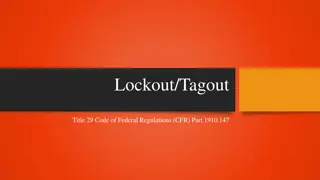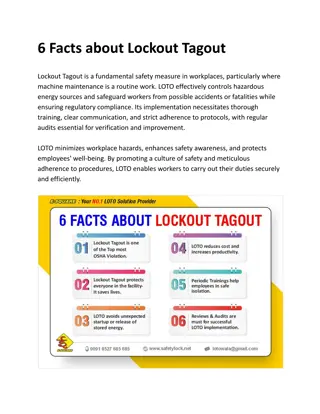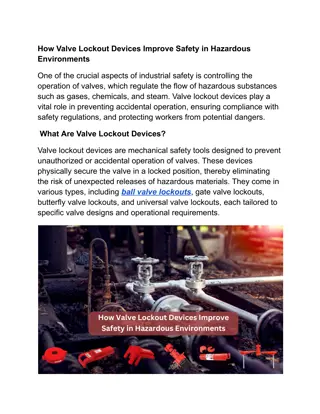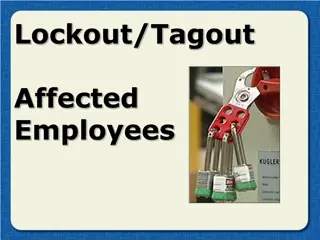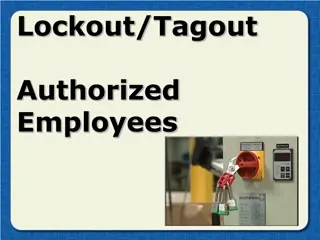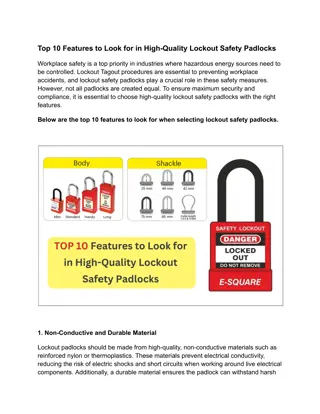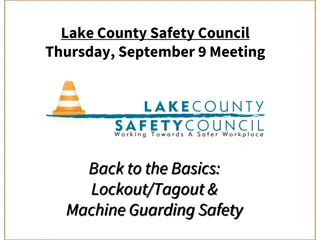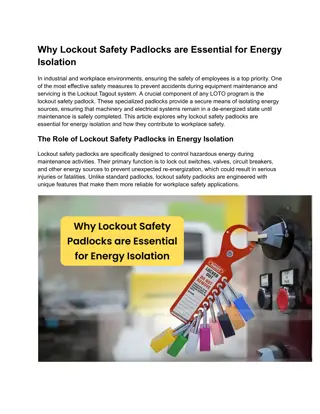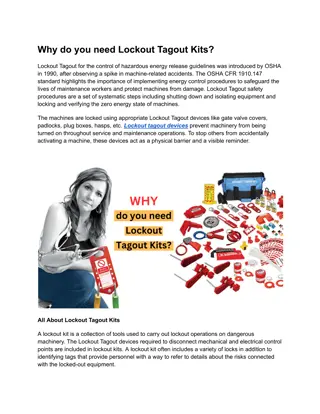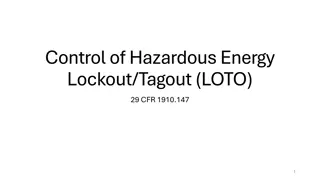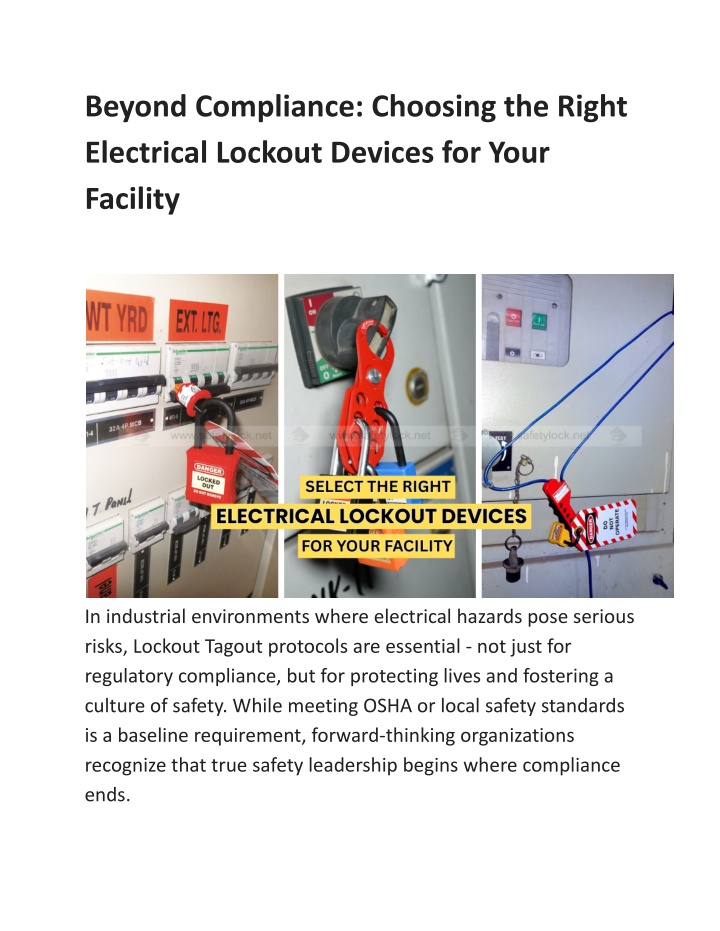
Beyond Compliance_ Choosing the Right Electrical Lockout Devices for Your Facility
In industrial environments where electrical hazards pose serious risks, Lockout Tagout protocols are essential - not just for regulatory compliance, but for protecting lives and fostering a culture of safety. While meeting OSHA or local safety standa
Download Presentation

Please find below an Image/Link to download the presentation.
The content on the website is provided AS IS for your information and personal use only. It may not be sold, licensed, or shared on other websites without obtaining consent from the author. If you encounter any issues during the download, it is possible that the publisher has removed the file from their server.
You are allowed to download the files provided on this website for personal or commercial use, subject to the condition that they are used lawfully. All files are the property of their respective owners.
The content on the website is provided AS IS for your information and personal use only. It may not be sold, licensed, or shared on other websites without obtaining consent from the author.
E N D
Presentation Transcript
Beyond Compliance: Choosing the Right Electrical Lockout Devices for Your Facility In industrial environments where electrical hazards pose serious risks, Lockout Tagout protocols are essential - not just for regulatory compliance, but for protecting lives and fostering a culture of safety. While meeting OSHA or local safety standards is a baseline requirement, forward-thinking organizations recognize that true safety leadership begins where compliance ends.
Choosing the right electrical lockout devices is a strategic decision that reflects a facility s commitment to operational integrity, workforce empowerment, and long-term risk mitigation. The Real Cost of Electrical Hazards: Electrical energy is invisible, silent, and unforgiving. Accidental energization during maintenance or servicing can lead to severe injuries, fatalities, and costly downtime. Regulatory bodies across the globe, including OSHA in the United States, mandate strict LOTO procedures to control hazardous energy. However, the effectiveness of these protocols depends heavily on the quality and suitability of the devices used. Facilities that go beyond compliance invest in lockout systems that are intuitive, durable, and tailored to their unique operational needs.
Types of Electrical Lockout Devices: Selecting the right electrical lockout devices requires a clear understanding of your facility s equipment, energy sources, and operational workflows. Each device serves a specific purpose in isolating electrical hazards and preventing accidental energization during maintenance or servicing. Here s a more detailed look at the key types:
Circuit Breaker Lockouts: Used to isolate power at its source, these devices come in snap-on, clamp-on, and universal designs. They fit various breaker types - from miniature control panel breakers to large industrial units. Check differenttypes of circuit breaker lockouts. Plug Lockouts: These enclose electrical plugs, stopping them from being inserted into outlets. Ideal for portable tools and equipment, they come in multiple sizes to suit standard and high-voltage plugs.
Electrical Panel Lockouts: These restrict access to switchboards and control cabinets, locking panel doors to prevent tampering or premature energization. Fuse Lockouts: Essential for older systems, these prevent fuse removal or replacement during servicing, keeping circuits safely de-energized.
Push Button Lockouts: These cover emergencies stop buttons and selector switches, blocking unauthorized or accidental use, especially in high-traffic or shared workspaces.
Cable Lockouts: Highly adaptable, cable lockouts use insulated cables looped through multiple isolation points. They re ideal for complex setups like grouped panels or disconnect switches.
Lockout Kits: Comprehensive kits include padlocks, tags, hasps, and various lockouts - streamlining deployment for maintenance teams and supporting consistent safety practices across zones.
Each device plays a critical role in isolating energy sources and reinforcing procedural discipline. Key Considerations When Choosing Devices Beyond the basic function, the best electrical lockout devices share several important characteristics: Durability - Must withstand harsh industrial conditions including heat, moisture, and chemical exposure. Visibility - Bright colors and clear labeling help reinforce awareness and prevent accidental override. Ease of Use - Simple application and removal encourage consistent use and reduce downtime. Customization - Bilingual tags, region-specific labeling, and modular kits support diverse teams and global operations.
Training Support - Devices should be backed by clear instructions and training resources to ensure proper implementation. Facilities that prioritize these features are better equipped to build a safety culture that is proactive, inclusive, and resilient. Safety as a Leadership Statement: Choosing the right electrical lockout devices is more than a procurement decision - it s a declaration of values. It signals that the organization prioritizes human life, respects regulatory frameworks, and invests in long-term safety outcomes. Facilities that lead with safety often see improved morale, reduced incidents, and stronger reputations within their industries. In regions like the United States, where regulatory scrutiny is high, and in emerging markets where safety awareness is growing, the right LOTO strategy can be a competitive advantage.
Final Thoughts Going beyond compliance means choosing tools that empower - not just protect. Electrical lockout devices are the frontline defense against invisible threats, and selecting the right ones is a responsibility that should never be taken lightly. Facilities that invest in high-quality, well-designed LOTO systems are not just meeting standards - they re setting them. They re building trust, saving lives, and shaping a future where safety is not a checkbox, but a core value.




